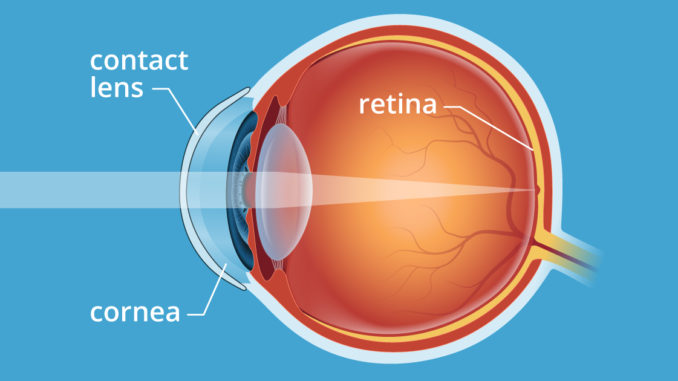
Contact lenses are used for vision correction and are placed on the cornea of the eye. They do the same corrective function that conventional spectacles, or glasses, do. However, in comparison, they are very light in weight and are, for all purposes, invisible. Contact lenses help form the image on the retina of the eye by either converging or diverging the rays of light entering the eye.
Earlier contact lenses were made of glass, and were scleral lenses. Scleral lenses are large contact lenses that cover the complete sclera – the white outer coating – of the eye. These unwieldy lenses could only be worn for a short period at a time. With the development of PPMA – polymethyl methacrylate – in the 1930s, plastics were first used in contact lenses. These were in fact, hybrid scleral lenses, made with the combination of both, glass and plastic, in 1936.
By the 1950s, much smaller contact lenses were developed that covered only the cornea of the eye and not the whole eye.
Types of Vision Impairments
One of the major uses of contact lenses is to correct visual defects. The general impairments are Myopia, Hyperopia, Astigmatism, and Presbyopia.
- Myopia – is a visual disability where the image of the object seen is formed in front of the retina. During this visual impairment, one can see objects that are near, and not the distant objects, which appear blurred. This defect is also known as nearsightedness. This is a very common impairment, with over 25 percent of the adults in the United States suffering from it. The defect can be corrected by the use of concave contact lenses.
- Hyperopia – It is also known as Hypermetropia, and the image of the object is formed behind the retina. Far objects can be seen clearly, and the near objects appear to be blurred. Hyperopia is more commonly known as farsightedness, and more than 13 percent of the children in the United States, in the age group 5 to 17, suffer from it. The defect can be corrected by the use of convex contact lenses.
- Astigmatism – This happens when the lens of the eye has more than one focal point, in different meridians. Astigmatic people cannot see in fine detail, and need cylindrical lenses to correct their impairment. Nearly 34 percent of American children in the age group 5 to 17 have this impairment.
- Presbyopia – This is an impairment, which comes with age, generally after the age of 40. The impairment develops as the lens of the eye loses its elasticity. Bifocal contact lenses are used to correct this vision defect.
Lenses Used For Vision Correction
In the case of normal vision, the light from the object hits the cornea and focuses on the retina. Due to some refractive error, at times the light from the object does not focus on the retina, but either in front of it, or behind it. To correct this refractive error, contact lenses are used to focus on to the retina.
The type of contact lenses used depends on the type of vision impairment, and how much refractive error is involved. How much the lens bends the light to focus on the retina is measured in diopters (D).
Myopia occurs when the light is focused in front of the retina, as the eyeball is longer than normal. To correct this impairment, which is also known as nearsightedness, a concave lens is used. This lens is thinner at the center, and helps move the focus ahead, towards the retina.
To correct this vision impairment, the curvature in the concave contact lenses is determined by the measurement in diopters. The larger the number of diopters, larger is the vision defect. In myopia, the diopter number is preceded by a minus (-) sign, denoting that the focus is short of the retina.
In the case of hyperopia, the light is focused beyond the retina. Hyperopia is also known as farsightedness, as distant objects are seen clearly in this impairment. The eyeball is shorter than normal, and a convex lens is used to correct this vision defect. The contact lens used is thicker in the center, and helps move the focus back onto the retina.
In this case, too, the curvature required in the convex contact lenses is determined by the measurement in diopters. The diopter number is preceded by the plus (+) sign, denoting that the focus is beyond the retina.
The lenses used for the correction of myopia and hyperopia are categorized as spherical contact lenses.
When the cornea is irregularly shaped, the light from the object falling on the cornea focuses on more than one point. This distortion of the image is called astigmatism. Special lenses need to be designed, based on the individual’s distortion of image. These lenses are known as toric lenses.
Though toric lenses are made of the same materials as the spherical lenses, they are specifically designed to suit individual impairments. These lenses have different curvatures, thicker in some places, and thinner in others. These lenses are designed to correct astigmatism and myopia or hyperopia, if required.
For the correction of presbyopia, special bifocal lenses are required, as the person suffering from it requires both correction for nearsightedness and farsightedness. In such lenses, either the correction for near impairment is placed in the center of the lens, with the distant correction on the outside, or vice versa.
Types Of Contact Lenses
The initial lenses were rigid lenses that did not absorb water. This kept the oxygen from passing into the cornea of the eye, causing eye irritation and other discomforts.
Then came the soft contact lenses made from hydrogel, which allowed oxygen to pass through them to the cornea. These lenses came to be known as ‘breathable’ contact lenses. This made it possible for contact lenses to be worn comfortably and for longer periods. Today, there are:
Daily wear lenses, which are removed at night.
Extended wear lenses that can be worn for extended periods without removing.
Disposable lenses that can be discarded after a day, a week, or a few weeks.
In addition, there are color contacts, which are for cosmetic purpose.
Proudly WWW.PONIREVO.COM
Source by Michael John Wright



